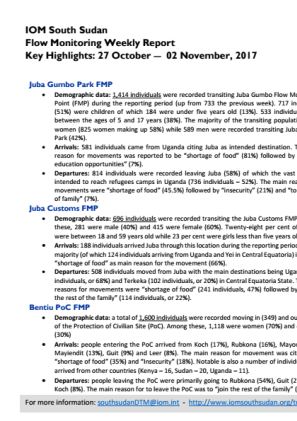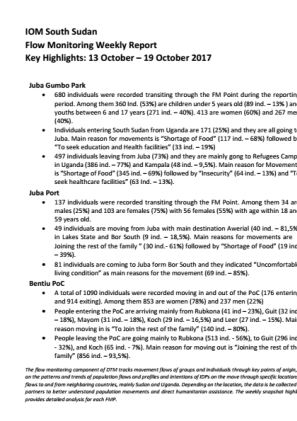-
Countries
-
Data and Analysis
-
Special Focus
-
Crisis Responses
South Sudan
South Sudan
Desplazados internos rastreados
Movimientos de desplazamiento
1,121,000
IDMC 2023
Ronda de recopilación de datos
Sobre South Sudan
Conflict and instability in South Sudan have resulted in large-scale internal and cross-border displacement since the December 2013 crisis of over 4 million individuals. In September 2018, the Revitalized Agreement for the Resolution of the Conflict in South Sudan (R-ARCSS) was signed between the major warring parties. Whilst overall there have been improvements in security since and returns are ongoing, fighting and communal clashes (frequently linked to cattle raiding) continue to trigger new displacements and the situation remains volatile.
DTM South Sudan’s toolbox is designed to meet critical information gaps during all phases of response, from preparedness, to intervention and transition/recovery. DTM South Sudan provides country-wide figures on the numbers, locations and priority needs of IDPs and returnees updated on a quarterly and ad-hoc basis. The programme undertakes biometric registration in selected parts of the country to support partners with reaching intended beneficiaries during distributions. Flow monitoring data is collected on a daily basis at displacement sites, key transit hubs and border crossing points to identify mobility dynamics of migrants including IPDs and returnees. Through ad hoc surveys, headcounts, infrastructure/service mapping exercises and other assessments, DTM provides additional information to support partners in planning their response.
Contacto
IOM South Sudan DTM Juba
ISSDTM@iom.int
Current Donors
- Switzerland
- Japan
- DFID
- ECHO
- OCHA
- OFDA
- Canada (DFATD)
- WFP
- UN Peacebuilding Fund
- World Bank
Para obtener resultados de búsqueda más avanzados, vaya a la Página de búsqueda avanzada de informes
South Sudan — Bentiu PoC Flow Monitoring Update (1—31 January 2018)
This report indicates how many people moved when and for what reason in and out of the Bentiu PoC. This does not include daily commuters going to work or school, and not all persons exiting the PoC and collective sites are returnees.
South Sudan — Wau PoC & Collective Sites Flow Monitoring Update (1—31 January 2018)
This report indicates how many people moved when and for what reason in and out of the Wau Protection of Civilians (PoC) and collective sites.
Feb 19 2018
South Sudan — Wau PoC & Collective Sites Flow…
South Sudan — Malakal PoC Flow Monitoring Update (1 January — 4 February 2018)
This report indicates how many people moved when and for what reason in and out of the Malakal Protection of Civilians (PoC) displacement sites. This does not include daily commuters going to work or school, and not all persons exiting the PoC are returnees.
South Sudan — Flow Monitoring Weekly Report (26 January — 1 February 2018)
IOM conducted flow monitoring at Protection of Civilian (PoC) and Wau collective sites. Flow monitoring captures the movement dynamics of the displaced population in the country.
South Sudan — Flow Monitoring Weekly Report (12—17 January 2018)
IOM conducted flow monitoring at various cross border points, transit areas, PoCs, and IDP Collective sites across South Sudan. During the reporting period, DTM tracked 11,394 individuals (57% female) transiting 17 active Flow Monitoring Points (FMPs).
South Sudan — Yambio Village Assessment Survey (23 January 2018)
DTM conducted a Village Assessment Survey in Yambio Payam in December 2017 to inform humanitarian partners about gaps in available services that could impede returns. 13 out of a total of 52 villages were deserted (25%). 31 out of 52 villages had water points (60%).
South Sudan — Flow Monitoring Weekly Report (5—11 January 2018)
IOM conducted flow monitoring at various cross border points, transit areas, PoCs, and IDP Collective sites across South Sudan.
South Sudan — Intentions and Needs Survey – Wau (December 2017)
The Displacement Tracking Matrix (DTM) team conducted the intention survey between 9 and 16 November 2017 in six of the collective sites, with a sample size of 823 households comprising 5,127 individuals out of a total of 45,445 individuals (9,885 households) currently living in those six sites.
South Sudan — Flow Monitoring Weekly Report (22—28 December 2017)
IOM conducted flow monitoring at various cross border points, transit areas, PoCs, and IDP Collective sites across South Sudan.
South Sudan — Intentions and Needs Survey – Pathai Payam (December 2017)
In Pathai Patham, most IDPs arrived between February and April 2017 from within Uror County, Jonglei State fleeing insecurity; 78% intend to stay, mainly because of access to security.
South Sudan — Intentions and Needs Survey – Pulchuol, Jonglei State (December 2017)
IOM’s DTM and NFI teams carried out an intetions survey and muti-sectoral needs assessment from 25 October to 1 November 2017 in Pulchuol, Jonglei State.
South Sudan — Flow Monitoring Weekly Report (1—7 December 2017)
IOM conducted flow monitoring at various cross border points, transit areas, PoCs, and IDP Collective sites across South Sudan.
South Sudan — Wau Village Assessment Survey (November 2017)
The objective of this VAS report was to provide baseline data to map the basic needs and critical gaps of services in the payams, Wau North and South.
South Sudan — Flow Monitoring Weekly Report (24—30 November 2017)
IOM conducted flow monitoring at various cross border points, transit areas, PoCs, and IDP Collective sites across South Sudan.
South Sudan — Flow Monitoring Weekly Report (17—23 November 2017)
IOM conducted flow monitoring at various cross border points, transit areas, PoCs, and IDP Collective sites across South Sudan.
South Sudan — Flow Monitoring Weekly Report (10—16 November 2017)
IOM conducted flow monitoring at various cross border points, transit areas, PoCs, and IDP Collective sites across South Sudan.
South Sudan — Intentions and Needs Survey – Wiechjol Payam, Akobo County (September 2017)
DTM conducted an intention and a multi-sectorial needs survey in Wiechjol (Jonglei State) to create a prole of the displaced population.
South Sudan — Flow Monitoring Weekly Report (3—9 November 2017)
IOM conducted flow monitoring at various cross border points, transit areas, PoCs, and IDP Collective sites across South Sudan.
South Sudan — Flow Monitoring Weekly Report (27 October — 2 November 2017)
IOM conducted flow monitoring at various cross border points, transit areas, PoCs, and IDP Collective sites across South Sudan.
South Sudan — Flow Monitoring Weekly Report (20—26 October 2017)
IOM conducted flow monitoring at various cross border points, transit areas, PoCs, and IDP Collective sites across South Sudan.
South Sudan — Flow Monitoring Weekly Report (13—19 October 2017)
IOM conducted flow monitoring at various cross border points, transit areas, PoCs, and IDP Collective sites across South Sudan. Flow monitoring captures the movement dynamics of the displaced population in the country.
South Sudan — Wonduruba, Lainya County Rapid Needs Assessment Report (18—25 August 2017)
DTM and NFI teams collected updated information on the number and needs of IDPs within South Sudan in the areas of Lainya and Wonduruba. A total of 2,397 displaced households were recorded in Wonduruba, while 2,389 or 4,659 households were recorded as displaced, depending on the source.
South Sudan — Flow Monitoring Weekly Report (15—21 September 2017)
A significant decrease (23%) was recorded in people transiting through Juba Gumbo Park compared to the previous week (1083 individuals compared to 1401).
South Sudan — Flow Monitoring Weekly Report (25—31 August 2017)
In this Flow Monitoring Weekly Report, it was found that there was a significant decrease (by 63%) in exits from Malakal PoC in comparison to the last week. 65 individuals exited during this reporting period in comparison to 178 individuals last week.
Pagination
Para obtener resultados de búsqueda más avanzados, vaya a la Página de búsqueda avanzada de conjuntos de datos
Pagination
- First page
- Previous page
- 1
- 2
- 3
- 4
- 5
- 6
Pagination
- First page
- Previous page
- …
- 13
- 14
- 15
- 16
- 17
- 18
- 19
- 20
- 21


























